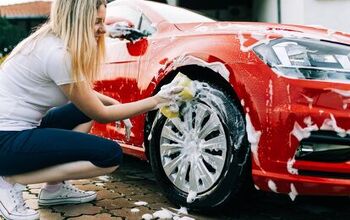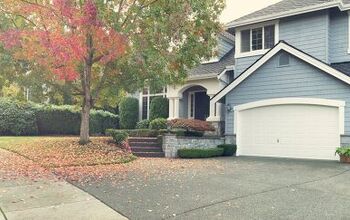What Is An Aggregate Driveway? (Find Out Now!)

Curb appeal is all about having visual interest on the outside of your home. Even though a driveway takes center stage, many homeowners opt for grey concrete or black asphalt. An exposed aggregate driveway is far more interesting.
Aggregate driveways have some of the crushed rock and stone exposed. Use exposed aggregate to add color and texture to your driveway. Exposed aggregate also has more traction than standard concrete, making it ideal for colder climates.
Let’s delve into exposed aggregate driveways and learn more about this aesthetically pleasing material.
Do You Need Concrete, Brick, or Stone Pros?
Get free, zero-commitment quotes from pro contractors near you.

What is an Aggregate Driveway?
Aggregate is any type of rock or stone that is mixed with cement to make concrete. With normal concrete, the amount of cement binder hides the aggregate. An exposed aggregate driveway has less cement, leaving the stone and rocks exposed.
How Strong is an Aggregate Driveway?
After a 28-day cure time, an exposed aggregate driveway is graded at 20 megapascals (MPA), or about 2,900 psi. Normal concrete is graded at 17.5 MPA, or 2,540 psi. Aggregate driveways are stronger because the cement binder needs to hold the exposed stones in place, as well as withstand the weight of vehicles.
Exposed Aggregate Driveway Pros and Cons
As with any driveway material, exposed aggregate has pros and cons.
Pros of an Aggregate Driveway
Some of the advantages of an exposed aggregate driveway are:
- Same materials as standard concrete
- Cost-effective
- Excellent variety of aggregate material
- No routine maintenance
- Clean with water
- Seal every 2 to 3 years
- Weather-resistant
Cons of an Aggregate Driveway
You should also consider the disadvantages of an exposed aggregate driveway, such as:
- Best done by a professional
- Dislodged stones leave holes in the driveway
- Stones may need to be replaced
- More difficult to patch cracks and holes
- Matching stones for repairs can be challenging
How Much is an Exposed Aggregate Driveway?
The cost of an exposed aggregate driveway is comparable to a concrete driveway. Expect to pay $8 to $10 per square foot for the materials and labor.
Protect your investment by working with a contractor who specializes in exposed aggregate. The finish requires a different technique than what is used for normal concrete driveways.
Aggregate Driveway Installation
Installing an aggregate driveway begins much the same way as a normal concrete driveway. Build a frame around the driveway to hold the concrete in place. Pour and smooth the concrete.
Exposing the aggregate can be done in several ways. For freshly poured concrete, spray it with water, and use a broom to remove a layer of cement. You can also use a pressure washer on a low psi setting.
If the concrete is already hardened, expose the aggregate with a shotblaster or sandblaster. Removing the outer layer of cement in this way may damage the natural color of the aggregate or break the stones.
What Types of Stones Can You Use for Exposed Aggregate?
You want stones that are relatively smooth. The most popular stones that are used for exposed aggregate applications are quartz, basalt, limestone, and granite.
Aggregate Driveway Sealer
Sealing an exposed aggregate driveway protects it against water infiltration and extends the life of your driveway. Use the same type of penetrating sealer that is used on concrete.
When is the Best Time to Seal an Aggregate Driveway?
The best time to seal an aggregate driveway is after the concrete is fully cured. This typically takes 28 days.
How Often Do You Seal an Aggregate Driveway?
Apply a new coat of sealer to your driveway every 2 to 3 years. If you notice water penetrating the surface, or if you find cracks or holes, seal the aggregate more often.
How to Clean an Aggregate Driveway
Cleaning an aggregate driveway is as easy as spraying it with water. Exercise caution when using a pressure washer on exposed aggregate. Keep the setting below 3,000 psi. Any higher, and you may dislodge the rocks and stones.
Can You Sandblast an Aggregate Driveway?
You shouldn’t sandblast an aggregate driveway. The sand breaks down the cement between the stones. You’ll end up with dislodged stones, water penetration, and holes in your driveway. The sandblasting may also create channels between the rocks, and this can affect how well water drains from the driveway.
Aggregate Driveway Repair
Repairing holes, cracks, and stains on an aggregate driveway is a bit more involved than with a standard concrete driveway. You need to maintain the aesthetic of the finish. Keep some of the original aggregate material on hand for repairs.
How to Fix Cracks in an Aggregate Driveway
Fix a crack in your aggregate driveway by filling in the gap with a few of the original rocks. Try to match the color and orientation of the surrounding stones. Add a slurry of cement and water. Use a damp, soft cloth to remove the slurry from the exposed surface of the stones.
How to Remove Oil Stains from an Aggregate Driveway
With normal concrete, you can remove oil stains by sanding the surface. Exposed aggregate requires a different approach. Fortunately, you can do the job without chemicals. All you need are some common household products.
Cover the oil stain with baking soda, and let it sit for 15 to 30 minutes. Scrub the area with a bristle brush, and rinse with clean water. Repeat for more stubborn oil stains.
Grease-fighting dish soap is another great way to remove oil from your aggregate driveway. Spread it over the oil stain, and let it sit for about 60 minutes. Wipe clean with a damp cloth.
Do You Need Concrete, Brick, or Stone Pros?
Get free, zero-commitment quotes from pro contractors near you.

Related Questions
Can you use exposed aggregate for a swimming pool deck?
Yes. Exposed aggregate is a perfect material for a pool deck. It looks good, and it is slip-resistant.
Is exposed aggregate the same as tar-and-chip?
No. Exposed aggregate is set in cement. Tar-and-chip driveways are made with crushed stone and hot tar. The stones are not exposed, and the technique uses a different binder.
Conclusion
An aggregate driveway adds interest and curb appeal to your home, and it stands up to the same use as regular concrete. It is also a great opportunity to be creative by combining different sizes and colors of rocks.

Jennifer L. Eggerton loves being hands-on, whether it's with a home DIY project, making repairs, re-decorating a room, or keeping life organized. She enjoys helping people by sharing her knowledge, insights, and experiences, as well as her lessons learned. In addition to her work as a writer, Jennifer is a Jeep® overlander, self-published author, and nature photographer who loves being outdoors.
More by Jennifer Eggerton



























